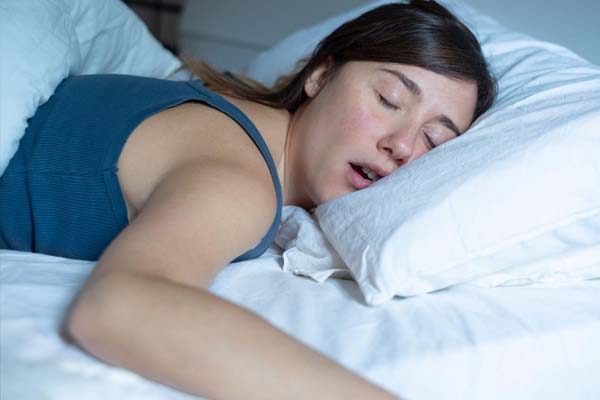The Department of Transportation (DOT) plays a crucial role in regulating transportation safety, including the safety of commercial drivers. One aspect of safety that the DOT has been paying increasing attention to in recent years is sleep apnea, a common sleep disorder that can affect a driver’s ability to safely operate a commercial vehicle.
Drivers who come in for a DOT physical exam may be surprised to learn that sleep apnea testing is not always required by the DOT. However, it’s important to understand that just because testing is not required does not mean that it is not recommended or beneficial.
Sleep apnea is a condition in which a person experiences pauses in breathing while sleeping. This can lead to disrupted sleep patterns, daytime fatigue, and other health issues. For commercial drivers, the potential impact of sleep apnea on driving safety is significant. Fatigue and drowsiness can impair a driver’s reaction time, decision-making ability, and overall performance, which can lead to accidents on the road.
While the DOT does not require sleep apnea testing for all commercial drivers, it does have guidelines in place regarding medical fitness for duty. These guidelines state that drivers with a history or risk of sleep disorders, including sleep apnea, should undergo evaluation and treatment as necessary to ensure they are medically fit to operate a commercial vehicle.


In short, even if the DOT does not require a sleep study, it’s important for commercial drivers to understand the potential impact of sleep apnea on their driving safety and to take steps to address any sleep disorders they may have.
By prioritizing their own health and safety, commercial drivers can help ensure that they are able to perform their jobs effectively and minimize the risk of accidents on the road.
What is sleep apnea?
Definition of sleep apnea and its types
Sleep apnea is a common sleep disorder in which a person experiences pauses in breathing or shallow breaths while sleeping. There are two main types of sleep apnea: obstructive sleep apnea (OSA) and central sleep apnea (CSA).
OSA is the more common type and occurs when the muscles in the throat fail to keep the airway open during sleep, resulting in blockage or narrowing of the airway. CSA, on the other hand, occurs when the brain fails to signal the muscles to breathe properly during sleep.
Causes and risk factors
The causes of sleep apnea can vary and may include factors such as obesity, smoking, alcohol use, and certain medications. In addition, some people may be genetically predisposed to sleep apnea. Risk factors for sleep apnea include being male, over the age of 40, having a family history of sleep apnea, and having a large neck circumference.
Symptoms and health effects
Symptoms of sleep apnea can include loud snoring, gasping or choking during sleep, excessive daytime sleepiness, morning headaches, irritability, and difficulty concentrating. In addition to these immediate symptoms, sleep apnea can also have long-term health effects if left untreated. These can include high blood pressure, heart disease, stroke, and diabetes.
If you suspect that you may have sleep apnea, it’s important to speak with a healthcare professional. Diagnosis typically involves undergoing a sleep study, during which your breathing, heart rate, and other vital signs are monitored while you sleep.
Treatment for sleep apnea may include lifestyle changes, such as weight loss and smoking cessation, as well as the use of a continuous positive airway pressure (CPAP) machine or other breathing devices to help keep the airway open during sleep.
Signs a Driver Needs Sleep Apnea Testing:
If you’re a driver experiencing any of the following symptoms, it’s recommended that you get tested for sleep apnea:
Excessive Daytime Sleepiness: If you find yourself feeling consistently tired or fatigued during the day despite getting enough sleep, it could be a sign of sleep apnea.
Previous Sleep-Related Accidents: If you’ve been in an accident caused by falling asleep at the wheel or other sleep-related issues, it may be an indication of sleep apnea.
Witnessed Breathing Pauses: If someone has noticed that you stop breathing or gasp for air while sleeping, it could be a sign of sleep apnea.
Loud and Persistent Snoring: If you snore loudly enough to be heard through a wall or door, it could be a symptom of sleep apnea.
If you’re experiencing any of these symptoms, it’s important to speak with a healthcare professional about getting tested for sleep apnea. Proper diagnosis and treatment, such as using a continuous positive airway pressure (CPAP) machine or other breathing devices, can help manage symptoms and improve your overall health and safety while driving.
A Driver Without Symptoms:
Even if a driver doesn’t exhibit any of the symptoms mentioned previously, they may still be at risk for sleep apnea due to certain factors. Here are some risk factors that indicate a driver should get tested for sleep apnea:
High BMI: If the driver has a body mass index (BMI) of 33 or greater, it increases their risk of developing sleep apnea.
Larger Neck Size: Neck size of 17 inches or greater for a male or 16 inches or greater for a female can indicate an increased risk of sleep apnea.
Presence of Other Diseases: Drivers who have high blood pressure, diabetes, heart disease, hypothyroidism, a history of stroke, or other related conditions may be at a higher risk of sleep apnea.
Age and Gender: Male drivers over the age of 50 and female drivers who are post-menopausal are more likely to develop sleep apnea.
Mallampati Score: The Mallampati Score measures the size of the tongue and throat and can be used to determine the risk of sleep apnea. A score of 3 or 4 increases the likelihood of sleep apnea.
If a driver has one or more of these risk factors, it’s recommended that they get tested for sleep apnea, even if they don’t have any symptoms. By taking proactive measures to diagnose and treat sleep apnea, drivers can improve their overall health and safety while on the road.
Arguments for Mandatory Sleep Apnea Testing:
Sleep apnea has been linked to the impaired driving ability and an increased risk of accidents. This is especially concerning for commercial drivers who spend long hours on the road. Here are some arguments for mandatory sleep apnea testing:
Studies Linking Sleep Apnea with Impaired Driving Ability:
Numerous studies have shown that sleep apnea can impair driving ability by causing excessive daytime sleepiness, decreased alertness, and slower reaction times. One study found that drivers with sleep apnea had a 2.5 times greater risk of being involved in a motor vehicle accident than drivers without sleep apnea.
Increased Accident Risk:
Commercial drivers with untreated sleep apnea are at an increased risk of being involved in accidents due to their impaired driving ability. This not only puts the driver at risk, but also other motorists on the road.
Safety Benefits of Mandatory Testing and Treatment:
By implementing mandatory sleep apnea testing and treatment for commercial drivers, we can improve overall road safety. Drivers who receive treatment for sleep apnea have been shown to have a lower risk of accidents and improved driving ability. This can lead to fewer accidents, injuries, and fatalities on the road.
Reduced Health Risks:
Untreated sleep apnea can also have serious health consequences, including high blood pressure, heart disease, and stroke. By identifying and treating sleep apnea in commercial drivers, we can reduce their risk of developing these health conditions and improve their overall health and well-being.
Best Practice Recommendations for Drivers with Prior Sleep Study:
For drivers who have had a prior sleep study, here are some best practice recommendations:
Second Sleep Study:
A second sleep study is recommended if the driver has developed additional risk factors since the first study was done, or if the driver has had a 10% increase in weight. This can help identify any changes in the driver’s sleep apnea and ensure that they are receiving appropriate treatment.
Proactive Health Management:
It is important for drivers to take proactive steps to manage their health, including treating any health conditions they may have. Most health problems will not prevent a driver from passing a DOT physical as long as they are receiving appropriate treatment. This can help ensure that drivers are healthy and safe on the road.
As a healthcare professional, I am here to help and I genuinely care about the safety and well-being of every driver. By following these best practice recommendations, we can work together to promote safer roads and healthier drivers.
